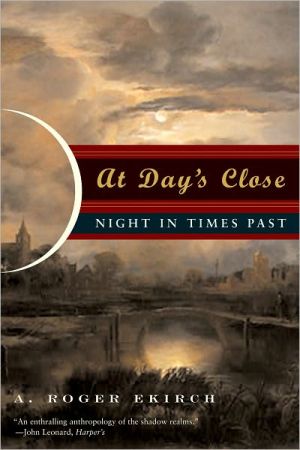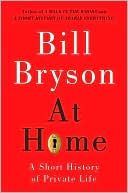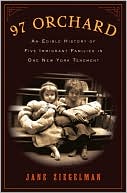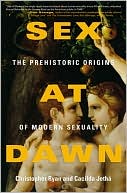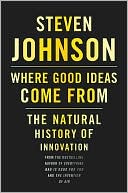At Day's Close: Night in Times Past
"Remarkable….Ekirch has emptied night's pockets, and laid the contents out before us."—Arthur Krystal, The New Yorker\ Bringing light to the shadows of history through a "rich weave of citation and archival evidence" (Publishers Weekly), scholar A. Roger Ekirch illuminates the aspects of life most often overlooked by other historians—those that unfold at night. In this "triumph of social history" (Mail on Sunday), Ekirch's "enthralling anthropology" (Harper's) exposes the nightlife that...
Search in google:
"Remarkable….Ekirch has emptied night's pockets, and laid the contents out before us."—Arthur Krystal, The New Yorker The Washington Post - Jonathan Yardley It's been thus for so many generations that we take it for granted: Night is when we go out, when we entertain, when we read, when -- of course -- we sleep. Yet in the long span of human history this is a relatively recent development. Not until "the period from 1730 to 1830," Ekirch argues in this interesting, original book, did the Western world undergo "such a sustained assault upon the nocturnal realm," and not until the 20th century and its near-universal use of artificial light did nighttime become what we know now. So At Day's Close is uncommonly welcome, for it covers ground that just about all others have ignored.
\ Jonathan YardleyIt's been thus for so many generations that we take it for granted: Night is when we go out, when we entertain, when we read, when -- of course -- we sleep. Yet in the long span of human history this is a relatively recent development. Not until "the period from 1730 to 1830," Ekirch argues in this interesting, original book, did the Western world undergo "such a sustained assault upon the nocturnal realm," and not until the 20th century and its near-universal use of artificial light did nighttime become what we know now. So At Day's Close is uncommonly welcome, for it covers ground that just about all others have ignored.\ — The Washington Post\ \ \ \ \ Publishers WeeklyEngrossing, leisurely paced and richly researched, this history finds Ekirch reminding us of how preindustrial Westerners lived during the nocturnal hours, when most were plunged into almost total darkness. By describing how that darkness spelled heightened risk-of stumbles, drowning, fires and other dangers-Ekirch accounts for the traditional association of nighttime with fear and suspicion, illuminating the foundations of popular beliefs in satanic forces and the occult. He also describes how the night literally provided a cloak of darkness for crimes and insurrections, and how fear of the night sometimes led to racist blame and accusation. A professor of history at Virginia Tech, Ekirch ranges across the archives of Europe and early colonial America to paint a portrait of how the forces of law and order operated at night, and he provides fascinating insight into nocturnal labor-of masons, carpenters, bakers, glassmakers and iron smelters, among many others. The hardest nocturnal workers were women, Ekirch writes, doing laundry after a full day's domestic work. Ekirch also evokes benign nighttime activities, such as drinking and alehouse camaraderie; the thrill of aristocratic masquerades; the merrymaking of harvest suppers and dances. A rich weave of citation and archival evidence, Ekirch's narrative is rooted in the material realities of the past, evoking a bygone world of extreme physicality and preindustrial survival stratagems. 8 pages of color and 60 b&w illus. (June) Copyright 2005 Reed Business Information.\ \ \ Kirkus ReviewsBefore the Industrial Revolution, the daily departure of the sun had effects on people far different from those we experience in our own brightly illuminated age. Why? A first-time author explains. Here, Ekirch (History/Virginia Tech) argues-and persuasively demonstrates-that darkness in earlier eras fostered "a distinct culture with many of its own customs and rituals." And he should know. He's researched his subject thoroughly (the endnotes run to 109 pages), trying with moderate success to cram into categories all he's discovered. Unquestionably, Ekirch gives us a vast number of arresting details: Earlier generations, for example, believed that noxious vapors came with night; they didn't admire sunsets; hanging the hearts of pigs over the hearth kept demons out of the chimney; humans have better night vision than most other animals; Pepys' wife (worried about his carnal dreams) would periodically inspect his penis during his sleep; and some early thinkers believed sleep was caused by fumes rising to the brain from the belly of the sleeper. But there are also a number of observations that seem too patent for the attention Ekirch gives them. He tells us that dark was more dangerous than light, that the night facilitated storytelling, that people drank a lot, that lovers and criminals used the cover of darkness, that some people had bad dreams, that bundling was fun, that chamber pots could smell bad. Nonetheless, he's done a creditable job of cataloguing the activities of the night-from nightwatching (a profession, he quips, probably older than prostitution) to enjoying masquerades to dung-burning to praying. He shows, too, that informal youth gangs sometimes ruled the dark streets in AClockwork Orange fashion, and he reveals that sleeping the entire night through was a rarity in an earlier age. Too many potential dangers (fire!), suspicious sounds, foul odors, strange bedfellows and inconsistent diets routinely ruined rest. A fascinating tale but, unfortunately, often in need of more graceful telling. (60 b&w illustrations, 8 pp. color illustrations, not seen)\ \
